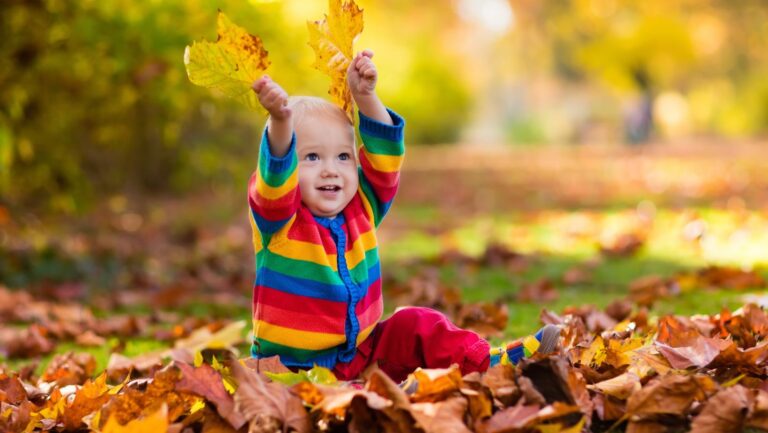Fall is a magical time for toddlers to explore the world around them, primarily through sensory play that stimulates their growing minds. As leaves change color, temperatures cool, and nature offers new textures and scents, the season provides a perfect backdrop for activities that both teach and entertain. Sensory experiences encourage toddlers to engage with their environment using multiple senses, improving motor skills, language, and cognitive development. This blog post shares creative fall-inspired sensory activities for toddlers that combine fun and learning, including ideas for Halloween and throughout the season.
Why Sensory Activities Matter for Toddlers
Sensory play involves activities that engage one or more of the five senses—touch, sight, hearing, smell, and taste. For toddlers, who are in the early stages of brain development, this multi-sensory stimulation supports exploration and fosters the development of neural connections. Engaging in sensory-rich activities enhances fine motor skills, problem-solving abilities, language acquisition, and emotional regulation. Fall offers a bounty of sensory opportunities with natural materials and seasonal themes that toddlers find fascinating. Incorporating these experiences into daily play helps children absorb new concepts while having fun.
Fall Leaf Exploration: Nature’s Sensory Treasure
Collect a variety of autumn leaves with different shapes, sizes, and textures during a family walk. Back home, toddlers can touch, crinkle, and compare the leaves, describing their colors and patterns. You can create a “leaf sensory tray” by layering leaves on a shallow box or tray, adding acorns, pinecones, and small sticks. Encourage toddlers to sort, count, or arrange them—boosting early math and language skills. This simple activity pairs tactile exploration with visual learning, encouraging curiosity about the natural changes.
Pumpkin Play: Squash and Sensory Fun

Toddler-friendly carving kits or safe scoops can add a creative, hands-on element to the experience. If you have outdoor space, these small garden storage sheds can be ideal for organizing all your pumpkin play supplies, keeping messes contained, and materials ready for repeated use.
Spiced Sensory Bottles and Sachets
Fall scents, such as cinnamon, nutmeg, and cloves, evoke feelings of coziness. Fill clear plastic bottles with rice or pasta and add a few drops of essential oils that represent the aromas of fall. Toddlers can shake and roll these sensory bottles, enjoying auditory and olfactory stimulation.
Alternatively, create small fabric sachets filled with dried spices and invite toddlers to smell, squeeze, and explore. These scent experiences encourage vocabulary development as children learn new descriptive words related to smell and texture.
Corn Kernels and Harvest Bins
Corn kernels offer a smooth, soothing texture that is perfect for sensory bins. Fill containers with dried corn kernels, adding small farming toys, scoops, cups, and funnels. Children love the tactile sensation of scooping and pouring, which simultaneously builds coordination and concentration. You can theme this as a harvest sensory bin to tie in fall’s agricultural traditions. Pair with stories or songs about farming to enhance comprehension and engagement.
Spooky Learning
As Halloween approaches, sensory bins themed with spooky but toddler-friendly items inspire imaginative play and exploration. Fill bins with black beans or colored rice and hide orange pom-poms as miniature “pumpkins.” Add plastic spiders, eyeballs, or bat shapes, all safe and soft for little hands. Halloween sensory bins mix sensory input with early sorting and counting challenges. It’s an enjoyable way to celebrate the season while building fine motor skills and encouraging descriptive language.
Nature Collages and Texture Boards
Create sensory collages by helping toddlers glue natural materials like leaves, bark, feathers, and acorns onto cardboard. This art activity combines tactile exploration with creative expression. Alternatively, design texture boards featuring various fall elements adhered to a sturdy board for toddlers to touch and describe. These boards encourage sensory discrimination and provide a visually stimulating learning tool.
Warmth and Comfort: Sensory Touch with Fabrics
Introduce fabrics in autumnal colors and textures for tactile play—soft fleece, rough burlap, silky ribbons, or knitted yarn. Let toddlers compare and contrast the materials, describing what they feel and see. Incorporate sounds, such as jingling bells attached to fabrics, for added stimulation. This activity supports sensory integration and pre-writing skills by strengthening finger muscles through the grasping and manipulation of materials.
Preparing Materials with Efficient Storage Solutions
Organizing sensory play materials can be a challenge, given the variety of natural and craft items used. Small sheds provide an ideal space to keep your bins, tools, and seasonal supplies neatly stored outdoors but easily accessible. This setup encourages regular, spontaneous sensory play throughout fall by simplifying cleanup and preparation.
Tips for Safe and Successful Fall Sensory Activities
- Always supervise toddlers during sensory play to avoid choking hazards.
- Choose non-toxic and child-safe materials, including natural elements.
- Introduce one new sensory item at a time to avoid overwhelming your child.
- Keep play areas contained with trays or bins for easy cleanup.
- Encourage toddlers to use descriptive language and ask questions while exploring.
Beyond immediate fun and learning, sensory activities in fall establish a foundation for lifelong curiosity and exploration. Experiencing nature’s seasonal changes connects toddlers emotionally to the outdoors, builds language and cognitive skills, and nurtures creativity.
As leaves fall and days grow cooler, these sensory experiences enliven toddlers’ understanding of their world, fostering joy and wonder with each tactile discovery.

